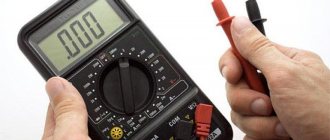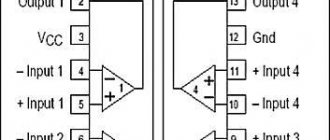17.07.2019
| (Votes: 2, Rating: 5) |
Issues discussed in the material:
- What voltage is considered normal on a car battery?
- How to check battery voltage under load
- What should the battery voltage be in winter?
- How to monitor car battery voltage
By analogy with the common saying that “the engine is the heart of the car,” the battery can be called the spinal cord of the car. The condition of the battery affects the performance of electrical equipment and the quality of engine starting. The most important parameter of a battery is voltage. This is the indicator that is measured when diagnosing a car. It is important for a car owner to know what the normal voltage of a car battery is, what the value of this parameter should be, and whether changing the battery voltage is allowed at different times of the year. You will find answers to these and other questions in our article.
What voltage is considered normal on a car battery?
It is worth noting that on the dashboard of modern car models there are no longer indicators showing the battery voltage value. In order to independently determine the performance of the battery, it is worth purchasing a multimeter. Using this device, you need to check the battery voltage indicator at least once or twice a month. This will prevent a situation where the battery will not be able to provide the normal starting current required to start the power unit.
At what minimum voltage will the battery be unable to start the engine? It is difficult to specify the exact value of this parameter. In normal condition, the battery voltage is 12.5-12.7 V. These numbers may vary depending on operating conditions, which is considered a normal situation. Moreover, some brands that produce car batteries indicate that the norm for their batteries is a voltage from 13 V to 13.2 V. Experts believe that such indicators are acceptable. In this case, the measurement should not be carried out immediately after the battery is fully charged. If you wait about 60 minutes, then its value will drop, for example, from 13 V to 12.7 V.
At the same time, the voltage indicator may change downwards. But if it drops below 12 V, then we can say that the car battery is about 50% discharged. In this case, the battery should be charged to normal voltage. Operating a car with a battery that has a low charge level is accompanied by sulfation of the lead plates, which leads to a decrease in battery life.
It is worth noting that under normal conditions, the power unit of a passenger car can be started even with low battery voltage. If the battery has no malfunctions, and the generator provides the necessary charge while the engine is running, then the battery can be used even with a low charge.
If the normal voltage of the car battery at rest (with consumers turned off and the engine turned off) decreases to less than 11.6 V, we can talk about the battery being almost completely discharged. In this case, it is unacceptable to operate the battery without checking its serviceability and recharging.
Summarizing the above information, we note that the normal voltage of a car battery is from 12.6 V to 12.7 V, but in rare cases it can reach 13.2 V. Quite often, when measuring this parameter, the batteries of passenger cars are recorded readings at 12.2-12.49 V (incomplete charge). Such indicators cannot be called very bad, since a noticeable decrease in the performance of a car battery is observed only when its voltage drops below 11.9 V.
We recommend
“How to choose a car battery: advice from car pros” Read more
Battery charge standards
Sometimes, to ensure the health of your battery, you need not only abstract readings like a float, but also precise measurements from a multimeter. This will help you verify that the battery is in good condition, carry out calculations, or find a reason to change the battery. Below you will find the battery charge standards, thanks to which you can draw conclusions about the charge of your battery.
Correlation table (state of charge/battery capacity/voltage/electrolyte density)
| Voltmeter reading (no load), V | Battery charge level, % |
| 12.6V or more | 100%, fully charged |
| 12.5 – 12.3V | 75-50% half |
| 12.1-11.7V | 25%-0% almost discharged – completely discharged |
Thus, the normal range for charging is 12.6 to 11.9V. Further indicators either indicate that the battery is completely discharged, or give reason to think about buying a new one. Readings are taken using a multimeter, as this is the best way to determine the battery charge level without any special tools. High-quality batteries hold a charge for a long period of time, withstand stress well and will not let you down in difficult times, so it would be best to purchase a high-quality battery. Batteries are not something you should skimp on, since a discharged car battery can lead to unpleasant consequences, for example, no one wants to stall somewhere far from civilization, especially if it is frosty or thunderstorm outside.
Normal car battery voltage under load
Experts distinguish 3 types of car battery voltage:
- Rated voltage is the characteristics that are given in special technical literature and in the documentation of car manufacturers. Anyone interested in motor vehicles knows that passenger car batteries have a voltage of 12 V. But such characteristics are abstract.
- The normal or actual battery voltage is 12.2 V - 12.7 V. The car battery produces these parameters without load.
- Voltage under load is considered the most important characteristic for assessing the condition of the battery.
To diagnose, the battery must be removed from the car and voltage applied to it using a special device called a “load fork.” In this case, the applied load to the battery should be 2 times its capacity. For example, for a battery with a capacity of 50 Amps, a load of 100 Amps should be applied. The duration of the load current supply is from 3 to 5 seconds. At this time, it is necessary to record the voltmeter readings. For a normal working battery, the voltage should not drop below 9 V. If this indicator is reduced to 5-6 V, then this indicates the need to charge the battery. If after charging the battery voltage drops below 5 V, this may indicate a battery malfunction.
One more important point should be noted. 5 seconds after applying the load, the car battery voltage should return to normal values (12.2 V - 12.7 V). These indicators depend on the density of the electrolyte in the battery. When the battery is discharged, acid is consumed, amounting to about 35% of the total electrolyte volume. As acid is consumed, the density of the electrolyte decreases. The acid percentage is restored while charging the car battery.
We recommend
“How to charge a car battery: methods, tips, features” Read more
How to determine the charge level
If you want to determine the car battery voltage and the degree of discharge, you can use a special circuit.
- If the multimeter reading is 12.6V or more, then there is a 100% charge;
- Having detected a value of 12.5V–12.06V, we can say that the battery is half discharged;
- 11.9V indicates a charge of 40%, having detected a decrease to 11.75V - 11.58V, a sufficiently strong discharge can be determined, further work is possible only after inspection and recharging;
- The critical level is 11.31V–10.5V, with a voltage of 10.5% representing 0% charge.
If during the test the display shows 8V or less, this indicates overcharging. It is most likely impossible to restore the device, since the plates begin to shed and the electrolyte becomes cloudy.
The density of the electrolyte is an equally important indicator that allows you to determine the degree of charge. A hydrometer is used here to obtain the results.
When fully charged, the electrolyte density is 1.27 g/cm 3 . The battery may be 50% discharged when the indicator drops to 1.2 g/cm 3 . Having identified a value of 1.1 g/cm 3, we can claim a complete discharge.
Testing the battery under load
The performance of the drive is very important; the quality of the car’s operation depends on it. All batteries can withstand a normal test with a multimeter, but a real load can easily identify working batteries and devices that have already exhausted their service life.
Testing using a load fork is a more professional approach used in services. Thus, you can obtain the most accurate data and check the effectiveness of the device itself and the degree of serviceability. Such a device includes a multimeter, a load resistor, and improved models also include an ammeter.
- The load plug must be connected to the terminals of the drive.
- During operation, a short circuit current will be supplied, which allows you to simulate the operation of a starter.
- As a result, the data on the display is evaluated, which corresponds to the degree of charge reduction when starting the car.
Such a check is carried out only at a battery temperature of 20–25 degrees. At lower temperatures, manipulations should be postponed, as the likelihood of a strong discharge and loss of capacity increases. The load calculation is made taking into account the capacity. If it is 55 A/h, the permissible load is 110 A. This effect lasts from 3 to 5 seconds.
Load fork readings:
- A result of 10.2V or more indicates the proper charge level;
- 9.6V and 9V – determine 75% and 50%, respectively; in the latter case, the device must go for charging (if it is winter, rapid discharge is possible);
- A result of 8.4V corresponds to 25% charge, and 7.8V or less indicates 0%.
Normally, during monitoring, the indicators should not fall below 9V, and after the load, the original voltage is restored in a few seconds.
The load plug should not be used frequently - the battery may be damaged and the capacity may be reduced.
Subtleties of proper battery charging
The need to charge the drive occurs when the voltage drops. Discharge is a natural process, especially at low temperatures and high network loads. To restore the charge, a special device is required - a direct current source capable of converting alternating current.
Sometimes car enthusiasts wonder how many amperes a charged battery will show. But the amp hours of a car battery indicate capacity, the ability to deliver a certain amount of current over a limited period of time. And a drive that is not under load will not show any values, since no current will flow. Knowing the capacity is necessary for proper charging and current calculation.
Normal car battery voltage in winter
As the air temperature decreases, the density of the electrolyte in the car battery changes. In this case, the characteristics of the battery depend on the degree of its charge. If the battery is charged, then as it gets colder, the density of the electrolyte will increase and the battery voltage will increase. When the charge is not high enough, then at sub-zero temperatures the density level decreases and it is more difficult to start the engine.
There is an idea among car owners that the normal voltage of a car battery without load in winter will decrease. In reality, at low temperatures, the battery voltage does not decrease, but chemical reactions slow down.
What battery parameters are considered normal in frosty weather? If the air temperature is within 10°C - 15°C with a “-” sign, then with a fully charged battery its normal voltage is 12 V. But since the electrochemical processes slow down, the following changes occur in the battery during frosts:
- At -30°C, the working capacity of the car battery is about 50% of the values indicated in the device passport.
- With a density of 1.28 g/cm3, the voltage at -30°C is 12.4 V, and at +25°C – 12.7 V.
- When the outside temperature drops below -25°C, the battery stops taking charge from the generator.
To increase the density of battery electrolyte in cars operated in northern regions, sulfuric acid is often added. With density values from 1.30 to 1.32 g/cm3, the normal battery voltage without load in frosty weather (from -10°C to -15°C) should be 12.9V. When increasing the concentration of H₂SO₄, you need to ensure that the electrolyte density does not exceed 1.35 g/cm3, as this will lead to corrosion of the plates.
We recommend
“How long to charge a car battery” Read more
How to find out the charge level of a car battery by its voltage
The simplest method is visual. Today, the degree of charge of the battery can be determined by looking at the hydrometric indicator (as it is called, the “eye”). Thanks to it, the degree of charge of the product is determined without improvised means:
The green color of the indicator indicates that the battery is charged more than 60%; dark color indicates the need to charge the battery; a light color indicates the battery's need for distilled water. You can also roughly determine the performance of the battery using a multimeter by measuring the voltage with the engine off, after leaving it for about 12 hours, as mentioned above. Measurements are carried out at a temperature of +18 C.
Here is a table of car battery charge by voltage:
| Performance level (%) | Voltage (V) |
| 100 | From 12.6 |
| 90 | 12,5 |
| 80 | 12,4 |
| 70 | 12,3 |
| 60 | 12,2 |
| 50 | 12,05 |
| 40 | 11,9 |
| 30 | 11,7 |
| 20 | 11,55 |
| 10 | 11,3 |
| 10,5 |
A mid-priced battery lasts approximately 3 years. If you follow the operating instructions all this time, the battery will not cause you any trouble. One of the main points here is to avoid deep discharge. After the three-year period, control over the battery should be strengthened: at least once every couple of weeks, measure the voltage of a fully charged battery, and, if possible, the density. After 4–5 years, it is recommended to replace the battery with a new one.
Causes of low voltage in a car battery
There can be several reasons for a sharp drop in voltage in a fully charged car battery:
- The battery has reached the end of its life and needs to be replaced.
- Due to a faulty generator, the battery does not receive the required charge.
- It happens that a new battery suddenly loses voltage even with a fully functional generator. This occurs due to current leakage from the vehicle's on-board electrical circuit. The reason for this situation can be any electrical equipment of the machine.
All existing causes of a drop in car battery voltage can be eliminated without much difficulty, except for the case when the battery has exhausted its service life. In this case, you need to buy and install a new battery.
Improper use of the vehicle can also lead to a decrease in the normal voltage of the vehicle battery. If the car is constantly used for short trips, then the generator does not have time to fully restore the battery after starting the engine. In addition, a decrease in battery voltage can occur due to the interior lights not being turned off, headlights running while the tape recorder is parked, etc. Even one electrical appliance turned on while the car is parked can completely drain the battery in just a few hours .
Overcharging the battery (battery voltage exceeds 13 V) is no less dangerous. Most often this happens due to improper operation of the generator. In some cases, car owners deliberately overcharge the battery to increase its density. When the battery voltage exceeds normal values, the electrolyte begins to boil away and the battery life is reduced. Let's look at the main reasons that lead to overcharging a car battery:
- The relay that turns off the generator after the battery is charged to normal voltage is not working properly. A malfunction of such a device results in the charging current continuing to flow after the battery has been fully charged. This breakdown is easy to fix, and the relay is not very expensive.
- Generator failure. In this case, repairs will be more expensive.
- The equipment for charging the car battery is incorrectly selected.
After the cause of the increased battery voltage has been eliminated, it is necessary to re-measure this parameter at the battery terminals to ensure normal operation of the equipment.
We recommend
“Is it necessary to do a wheel alignment after replacing silent blocks” Read more
Why do you need to control the charge?
A direct parameter that characterizes the level of “health” of a car battery is the voltage at the terminals. By monitoring this parameter, the owner can accurately determine when the battery needs to be recharged and the degree of suitability of the battery for use. Also, experienced car owners strongly recommend checking the voltage on the battery when purchasing at the market or in other dubious places, since you can buy an already discharged battery. It’s worth noting that it would be a good idea to get a voltmeter in the car’s interior to constantly monitor the voltage in the car’s network.
If we are talking about the voltage at the battery terminals, then the question reasonably arises about the normal operating voltage. The standard for passenger cars is a six-cell 12 V battery. There are two ways to measure battery voltage: measure the total voltage of the battery, or the voltage of each individual cell. It is worth noting that the second option allows you to more accurately determine the state of the battery and calculate the cell that drains the total voltage of the battery (all cells are connected in series).
How to choose a battery for a car
Battery characteristics, their normal values
The main technical characteristics of a car power supply include the following:
- Type - depending on the internal structure, the materials used and the chemical processes occurring inside the batteries, they can be lead-acid, calcium, hybrid, gel, alkaline (nickel-cadmium and lithium-ion);
- Voltage is the potential difference measured in Volts between the current-carrying contacts of the power source (terminals). The value of this characteristic ranges from 12 to 24 V.
- Capacity is a characteristic indicating how much electrical energy a battery can supply to various consumers. Capacity is measured in Ampere hours (Ah). The battery capacity ranges from 44 to 200-240 Ah and also determines the duration of operation of battery-powered consumers with a certain load current. The operating life of a battery of a certain capacity can be calculated by dividing the value of this characteristic by the load current of the network that will be powered by the battery.
- Discharge depth is the ratio of the minimum permissible capacity of the power source to the maximum value, expressed as a percentage. For most models used for cars, this figure is 75-80%. Completely discharging the battery is not recommended, as this leads to a loss of 1-2% of its capacity.
- Inrush current is a characteristic that indicates how much current the battery can produce over a short period of time. Typically it ranges from 360-640 A to 900-1200 A.
- The level and density of the electrolyte - depending on the climatic conditions in which the vehicle will be operated, ranges from 1.2 (for southern regions) to 1.28-1.29 g/cm3 (for northern regions).
- Weight – from 10 to 45-50 kg;
- Service life - with proper use and timely charging, the service life of the battery is up to 7-10 years.
- Temperature range of operation - most automotive power supplies are designed for use in conditions of both 40-degree frost and 45-50-degree heat.
Important! The choice of battery voltage is made taking into account the size and type of car engine. So, for passenger cars with gasoline engines, a 12-volt power source is sufficient. For heavy vehicles and special equipment equipped with powerful diesel engines, 24-volt power supplies are used.
A few words about electrolyte
The main parameter that determines the voltage level in the battery is the density of the electrolyte that is inside this device.
When the battery is discharged, acid is consumed, the share of which in this composition is 35 - 36%. As a result, the density level of this liquid decreases. During the charging process, the reverse process occurs: water consumption leads to the formation of acid, which results in an increase in the density of the electrolytic composition.
In the standard state at 12.7 V, the density of this liquid in the battery is 1.27 g/cm3. If any of these parameters decreases, the other also decreases.
How do the electrolyte density and battery voltage depend on the ambient temperature?
Car owners often hear that the car battery voltage can drop significantly in winter. You leave the car in the cold for several days, they say, and that’s it, then you won’t start it. That is why some of them remove and take the battery home.
What happens inside the battery at low temperatures and what can this lead to? In fact, the car battery voltage does not drop in winter. Yes, the density of the electrolyte changes, but for a charged battery it increases, and for a discharged battery it decreases. In other words, if the battery is discharged, it must either be charged or carried with you. Otherwise, not only will it not be able to start the engine in cold weather, but the electrolyte in it may freeze, which will lead to rupture of the housing.
A charged battery is not in danger of anything like this. Yes, sometimes problems arise with starting the engine, but only because at low temperatures chemical processes proceed much more slowly, so the battery may not produce the power required to start. But it’s enough to bring it into the heat and hold it for a while, and it will again be ready to work as before. Therefore, the normal voltage of a car battery for the winter period is no different from the values for the summer.
Why is this happening
Any battery has a certain resource, even with timely maintenance. Modern batteries, depending on operating conditions, can last from 3 to 7 years. After this period, the car battery voltage gradually begins to decrease. This is due to the destruction of lead plates, which, unfortunately, cannot be avoided over time. Of course, you can try to restore the battery, but it will no longer work like a new one.
If the generator malfunctions, the charging voltage of the car battery jumps, drops, or is completely absent. In this case, the battery operates in emergency mode, which can lead not only to its discharge, but also to its failure.
Current leakage is one of the main reasons for battery discharge. It is easily determined using an ammeter or multimeter turned on in its mode. By measuring the current between the removed ground terminal and the negative terminal of the battery, we determine the amount of leakage. If it is higher than 80 mA, you should immediately contact the service to find the leak and fix the problem.
Often, car owners independently install additional electrical appliances (speakers, subwoofers, lighting elements, various electronic devices), without even realizing that they significantly exceed the network load specified by the car’s passport data. This inevitably leads to the fact that the generator can no longer cope with this load, and part of it is covered by the battery.
It happens that unlucky drivers, sometimes leaving the car, simply forget to turn off the headlights, radio, interior lighting or other devices that consume electricity. This inattention also causes the battery to drain quickly.
A battery that is not serviced on time will also never work for long. Even if your car has a maintenance-free battery, you need to constantly look after it and periodically charge it.
Reduce voltage in winter
Car owners often complain that in winter, when there is severe frost, the main parameters of the battery drop, as a result of which the car does not start. Therefore, some drivers take the battery into a warm place at night.
But in reality, things are not quite like that. At negative temperatures, the density of the electrolyte changes, which, as already noted, affects the voltage level. But if the battery is sufficiently charged, the density of the electrolyte increases in cold weather, and as a result, the second of the most important properties also increases. Therefore, a sufficiently charged battery is not in danger even in severe frost. If you leave it discharged in cold weather, the density of the electrolyte will decrease, as a result of which problems will arise with starting the car engine.
Problems with using and starting a vehicle’s power unit in winter are not associated with a decrease in the basic parameters of its battery, but with the fact that the main chemical processes inside it at negative temperatures are slower than in normal times.
Normal and deviations in battery voltage readings at rest and under load
A battery under load has lower performance than at rest.
These indicators can tell a lot about the technical health of the unit. These indicators are measured using devices such as a load fork or a multimeter. When measuring with a multimeter, the switched on starter plays the role of a load.
Not everyone can do such manipulations, so it is better to entrust the procedure to a specialist. But you need to have at least a general idea of how your car’s battery works.
The power supply can be considered discharged when the device readings are less than 9 volts. If the battery produces such numbers after the recharging procedure, then it has become unusable and requires replacement.
When there is no load, the battery voltage (U) fluctuates between 12.6 -12.8 volts. The battery is considered discharged if the U value at rest is less than this figure.
If the charge is reduced and the power source is still used, this can lead to destruction of the plates and a drop in the unit’s capacity. The voltage of the battery at rest is measured without fail with the terminals removed.











